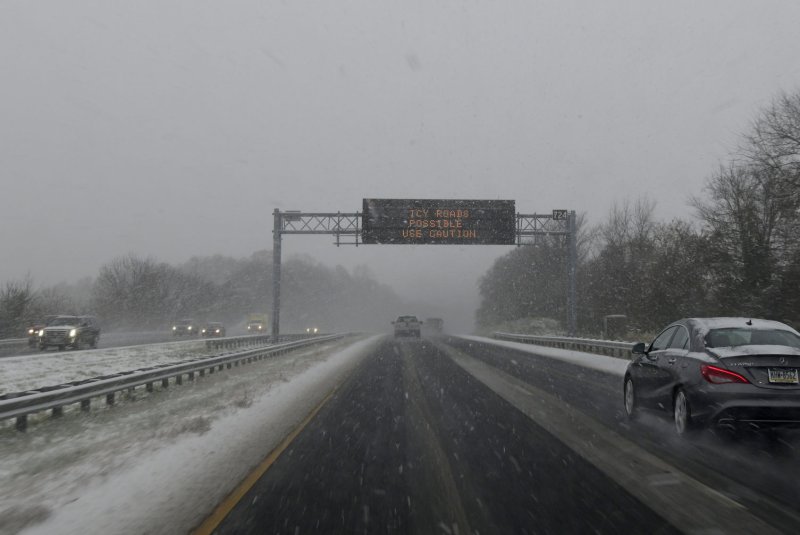Forecasters say a major storm could prove disruptive for millions of Americans who are planning to get a head start on Thanksgiving travel. File Photo by David Tulis/UPI |
License Photo
AccuWeather meteorologists are cautioning that a major storm could prove disruptive for millions of Americans who are planning to get a head start on Thanksgiving travel.
The concern forecasters have is that a significant storm could rapidly strengthen and cause a host of disruptions from the Midwest to portions of the Great Lakes, interior Northeast and mid-Atlantic over the weekend and the days before Thanksgiving.
Travel for Thanksgiving is expected to reach nearly pre-pandemic levels this year, according to AAA, and the repercussions of any storm that may develop in the days ahead of the holiday, AccuWeather forecasters warn, could be far-reaching and have lingering effects on the Wednesday before Thanksgiving, which is considered one of the nation's busiest travel days of the year.
The exact timing and track of the storm have yet to be pinned down, but the key scenarios forecasters say are possible point to a broad area of stormy weather developing early next week. Monday and Tuesday may bring the most disruptions, regardless of the exact path the storm ends up taking. Precipitation will come in the form of snow and rain depending upon location.
"We could be looking at a huge mess and a real wrench in holiday travel," AccuWeather chief meteorologist Jon Porter said.
One scenario AccuWeather meteorologists have been analyzing involves a storm that organizes over the central Plains on Sunday and then tracks northeastward toward the Great Lakes on Monday, and into central Ontario or western Quebec on Tuesday.
With this potential track, an area of heavy snow may spread across portions of Minnesota, northern Wisconsin, northern Michigan, and central portions of Ontario and Quebec. As the storm strengthens and pushes into Canada, high winds could develop as temperatures plunge across the Midwest and then the Northeast.
Shifting bands of lake-effect snow and snow squalls are then likely to unfold and could bring locally heavy accumulations from northern Indiana and Michigan to parts of Ohio, West Virginia, Pennsylvania, Maryland and New York state from Monday to Wednesday.
Even though the core of the storm's effects under this scenario would be centered on the Midwest and Great Lakes, a band of heavy rain and possibly severe thunderstorms may sweep eastward across the Southern states, Appalachians and Eastern Seaboard on Monday into Tuesday. The heavy precipitation could lead to flooding and disrupt travel for motorists.
Under the second scenario forecasters say is possible, a storm would evolve more slowly over the Midwest from Sunday to Monday. Then, a spinoff storm could form rapidly along the mid-Atlantic coast Monday before it shifts northward into the interior Northeast states Tuesday.
A period of intense rain perhaps with thunderstorms, high winds and flooding could erupt from the central Appalachians to the mid-Atlantic and spread rapidly northward into upstate New York, New England and southern Quebec from Monday into Tuesday night.
"This storm can bring a lot of rain to the Interstate 95 corridor," AccuWeather Lead Long-Range Meteorologist Paul Pastelok said, adding that flooding on streets and highways could result in major travel delays for motorists.
Across the central and southern Appalachians, a change from rain to a period of accumulating snow may occur due to the nature of the south-to-north storm track along the Atlantic coast.
Farther to the north, similar to the first scenario, heavy lake-effect snow and slippery travel would follow the storm as colder air pours in with gusty winds.
In either scenario, the storm could strengthen rapidly enough to be classified as a bomb cyclone as the central pressure of the storm could plummet 0.71 of an inch of mercury (24 millibars) within 24 hours.
Even more disruptive than the rain and snow could be the high winds unleashed by the storm. Widespread strong winds will develop across the central and eastern United States as the storm intensifies.
"A major storm may significantly compound airport and airline operational challenges that have plagued the air travel industry of late," Porter said, adding that delays in the East would likely cause ripple-effect delays nationwide.
Strong winds alone, with and without any thunderstorms, can cause substantial direct delays at major airport hubs in the Midwest, such as Chicago, Minneapolis and Detroit, as well as the major hubs in the East from Atlanta to Charlotte, N.C., Washington, D.C., Philadelphia, New York City and Boston from Monday to Tuesday.
The effects of the storm could even be felt across some Southern states in the days ahead of the big travel rush.
There is also the potential for severe thunderstorms to develop and sweep eastward from parts of the South Central states to the Atlantic coast, along the storm's strengthening cold front from Monday to Tuesday. As some people in the Northeast experienced this past weekend, severe weather, though rare in November, can occur. With any severe thunderstorm or high-wind event there is the risk of power outages and property damage.
When is the best time to hit the road or take to the air ahead of Thanksgiving?
People with flexible travel plans may want to consider starting a trip Friday night, Saturday or early Sunday, AccuWeather forecasters advise, to avoid potential highway backups, hazardous weather on the roads, or trip disruptions from the major storm to impact parts of the Midwest and Northeast by early next week.


















